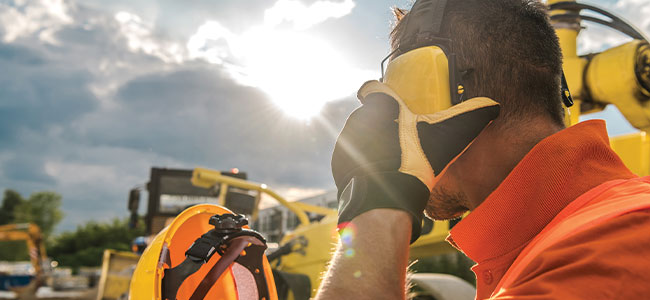
Improving Noise Monitoring and Your Hearing Conservation Program
From earplugs to personal headphones, it’s time to discuss the future of hearing protection in the workplace.
- By Tom Burgess
- Mar 01, 2024
Don’t underestimate the constant hum of equipment at your manufacturing facility or construction site — it’s more than just annoying; it’s also a serious safety hazard. Meeting the Occupational Safety and Health Administration’s (OSHA) standard of 85 decibels is only the beginning for employers. The nuances of workplace noise monitoring and hearing protection extend far beyond a simple numerical threshold, bringing forth challenges like fluctuating noise levels, identifying the appropriate personal protective equipment (PPE), and ultimately ensuring long-term worker protection.
At the heart of effective workplace noise management lies a deep comprehension of the dynamics of noise exposure, including understanding its cumulative nature. When assessing noise exposure, it’s important to remember that exposure limits are based on a time weighted average. Noise exposure is often not steady and can vary throughout the day and throughout the worksite. A worker might be exposed to loud noises in the morning but not in the afternoon, for example, emphasizing the need to assess day-long exposure.
Effectively mitigating noise-induced hearing loss begins with an accurate exposure assessment at the worksite. But a single decibel reading, captured at a singular moment, offers an incomplete picture. Data can be an unsteady foundation when decibels are involved. A standard type 2 sound level meter has an error range of +/- 2 decibels. So, an 84-decibel reading, below the OSHA hearing conservation limit, is potentially representative of a range between 82 and 86 decibels. While seemingly compliant with OSHA standards, such uncertainty is unacceptable for protecting the long-term health of workers.
While industrial sites and construction zones are commonly associated with high noise levels, the hard truth is that danger lurks in unsuspected corners. Maintenance teams with intermittent exposure to noisy pumps or compressors, custodians using powered equipment, or even seemingly innocuous settings like bustling kitchens, can all contribute to cumulative auditory damage. Some of these settings can be even more risky because workers and managers may be less aware of the potential threat and therefore less inclined to pursue protective measures.
Noise exposure does not solely reside in sustained decibel levels. Short bursts of intense noise, like a jackhammer’s roar or a jet engine’s scream, pack a potent punch that can overexpose workers even within a seemingly quiet workday. Furthermore, the insidious nature of hearing loss lies in its cumulative effect. Noisy evenings add to the workday’s burden, and the damage often manifests years later when older workers bear the brunt of past exposures.
While worker protection often relies on OSHA standards, the exposure limits and measurement criteria in the OSHA Noise standard do not protect workers adequately. Voluntary standards, like those recommended by the American Conference of Governmental Industrial Hygienists (ACGIH) and the National Institute for Occupational Safety and Health (NIOSH), provide a more protective framework.
Noise cancellation technology is an evolving technology making inroads into personal headphones. By generating countervailing waves that neutralize incoming noise, this technology actively reduces noise exposure improved listening and communication. While these innovations are great for personal use and hint at a future where active hearing protection can be used for occupational noise protection, at this time they are not approved for the workplace. Acceptable workplace hearing protection can be identified by the required Environmental Protection Agency (EPA) labeling.
We’re witnessing the rise of new and sophisticated hearing protection equipment. Headphones with built-in noise-cancelling microphones and speakers that allow workers to communicate without temporarily removing an earmuff or otherwise momentarily compromising their safety. Personal or area noise monitoring devices that monitor and analyze noise levels in real-time, providing information to workers allowing them to adjust protection and transmitting vital information to safety monitoring systems. Imagine a connected workspace where noise exposure data fuels predictive analytics, identifying high-risk areas and triggering preventative measures before damage occurs.
The wearable revolution extends beyond the ears. Even popular devices like the Apple Watch are now equipped with noise exposure alerts, empowering individuals to actively monitor their sound environment and make informed decisions about their hearing health. This democratization of noise monitoring gives workers agency, fostering a culture of proactive self-protection. It also helps integrate hearing protection into popular culture, beyond just the workforce.
These technological advancements and awareness-raising measures are empowering and important because as previously noted, hearing loss can happen over time, and it can be irreversible. Unlike a fractured bone, hearing loss heals silently, often going unnoticed until significant damage is done. The onus lies on employers, safety professionals, and even workers to comprehend the complexities of noise exposure and embrace personal protective equipment, training, and other safety measures.
Navigating the intricacies of workplace noise monitoring and hearing protection demands a multifaceted approach. Beyond adhering to OSHA standards, it involves a comprehensive grasp of the variability in noise exposure, reliance on updated voluntary standards, and embracing technological advancements.
Overlooking the importance of hearing protection goes beyond a simple safety oversight; a risk can affect an employee’s overall well-being. Continuous exposure to high noise levels can result in hearing impairments, ongoing tinnitus (a persistent ringing in the ears), and cognitive decline. Opting for hearing protection isn’t merely checking a box; it’s a proactive stance against a preventable, yet potentially life-altering, threat.
This article originally appeared in the February/March 2024 issue of Occupational Health & Safety.